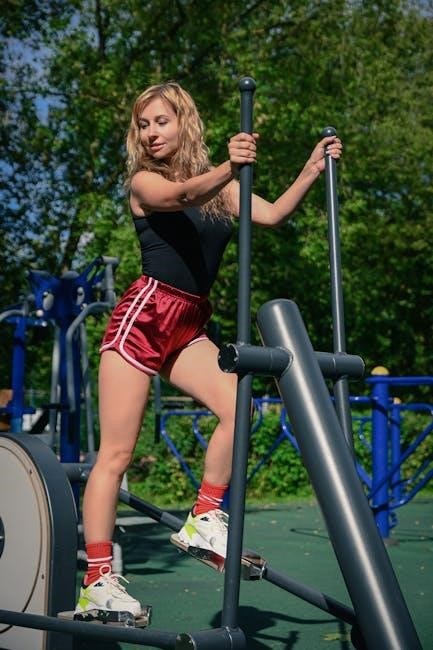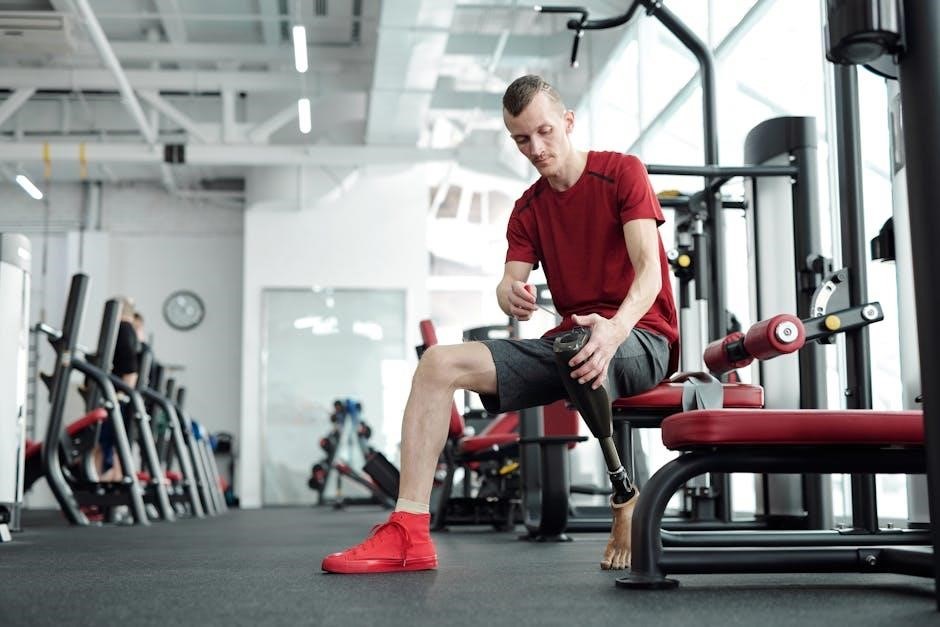This 30-day no-equipment workout program is designed for beginners, focusing on bodyweight exercises to improve strength, cardio, and flexibility. Perfect for home workouts, it requires discipline and consistency to achieve results.
Why Choose a No-Equipment Workout?
A no-equipment workout is ideal for its convenience and affordability. It eliminates the need for costly gym memberships or specialized gear, making it accessible to everyone. Bodyweight exercises engage multiple muscle groups simultaneously, promoting full-body strength and flexibility. This approach is perfect for all fitness levels, allowing modifications to suit individual needs. No-equipment workouts are also time-efficient, fitting seamlessly into busy schedules. They encourage consistency, helping you build a sustainable routine. Plus, they can be done anywhere, whether at home, outdoors, or while traveling. This flexibility makes no-equipment workouts a practical choice for those seeking a hassle-free way to improve their health and fitness without compromising results.
Benefits of a 30-Day Fitness Challenge
A 30-day fitness challenge offers numerous benefits, including improved physical health and mental well-being. It helps establish a consistent workout routine, boosting discipline and motivation. Participants often experience weight loss, increased strength, and enhanced cardiovascular health. The structured plan provides accountability, pushing individuals to stay committed. Many challenges are designed to be progressive, allowing for gradual improvement and reducing the risk of injury. Additionally, the sense of accomplishment upon completing the challenge can significantly boost self-confidence. The program’s short-term nature makes it less intimidating, encouraging adherence and laying a strong foundation for long-term fitness goals. Overall, a 30-day challenge is an effective way to kickstart a healthier lifestyle.
Understanding the Structure of the Program
The 30-day no-equipment workout program is divided into four weeks, each with specific focuses. Week 1 builds foundational strength and endurance through full-body and targeted exercises. Week 2 introduces circuit training and HIIT for increased intensity. Week 3 emphasizes progressive overload and core stability, challenging participants further. Week 4 culminates in a final push, incorporating max-effort workouts and endurance tests. Each week includes active recovery and rest days to ensure proper muscle repair and mental rejuvenation. The program alternates between strength, cardio, and mobility exercises, providing a balanced approach to fitness. This structured progression ensures steady improvement and minimizes the risk of plateaus or burnout.

Week 1: Laying the Foundation
Week 1 focuses on building a consistent routine with moderate-intensity exercises. It includes full-body workouts, upper and lower body focus days, cardio, and active recovery to establish a strong fitness base.
Day 1: Full Body Workout
Start with a dynamic full-body workout to engage all major muscle groups. Perform 10 push-ups, 10 squats, 10 lunges per leg, 10 mountain climbers, and 10 plank shoulder taps. This routine builds foundational strength and endurance, preparing your body for the challenges ahead. Keep the pace steady and focus on proper form to avoid injury. Rest for 30-60 seconds between sets and stay hydrated throughout. This workout sets the tone for a successful 30-day journey, promoting overall fitness and setting you up for progress in subsequent days.
Day 2: Upper Body Focus
Target your upper body with a series of effective no-equipment exercises. Start with 10 push-ups to engage your chest and triceps, followed by 10 tricep dips using a sturdy chair or bench. Perform 10 pike push-ups to challenge your shoulders, and complete 10 Superman holds to strengthen your upper back. Finish with 10 plank shoulder taps to improve core stability and shoulder mobility. Rest for 30-60 seconds between sets and maintain proper form throughout. This workout enhances upper body strength and sets the foundation for more intense routines in the coming days. Stay consistent and track your progress for the best results.
Day 3: Lower Body Focus
Engage your lower body with a dynamic workout. Begin with 15 squats to activate your quads and glutes, followed by 15 lunges per leg to target balance and strength. Perform 15 calf raises to strengthen your lower legs and 15 glute bridges to enhance hip mobility. Conclude with 30 seconds of side plank holds on each side to improve core stability. Rest for 30-60 seconds between sets and focus on controlled movements. This routine builds foundational strength and prepares your lower body for more advanced exercises. Consistency is key, so maintain proper form and gradually increase intensity as you progress through the program.
Day 4: Cardio and Core
Start with 30 seconds of mountain climbers to elevate your heart rate and engage your core. Follow with 15 plank shoulder taps to improve stability and burn calories. Perform 15 Russian twists to target your obliques. Next, do 15 bicycle crunches to focus on your lower abs. Conclude with 30 seconds of high knees for a cardio boost. Rest for 30-60 seconds between sets. This workout combines cardio and core exercises to enhance endurance and strengthen your midsection. Keep your movements dynamic and controlled to maximize results. Staying consistent with this routine will improve your overall fitness and prepare you for more challenging workouts ahead.
Day 5: Active Recovery
Active recovery focuses on light exercises to promote muscle repair and flexibility. Begin with 10-15 minutes of gentle stretching, targeting major muscle groups. Perform seated forward bends, child’s pose, and cat-cow stretches to enhance flexibility. Engage in 5-10 minutes of dynamic stretches, such as arm circles and leg swings, to improve mobility. Conclude with 5-10 minutes of deep breathing or yoga to reduce stress and rejuvenate your body. Avoid high-intensity activities today to allow your muscles to recover. Stay hydrated and listen to your body’s needs. This recovery day is crucial for maintaining progress in the program and preventing fatigue.

Week 2: Building Intensity
Week 2 increases intensity with circuit training, HIIT, and strength exercises. Includes mobility workouts and rest days to ensure proper recovery and progress.
Day 6: Circuit Training
Day 6 focuses on circuit training to boost endurance and burn calories. Perform 3-4 rounds of exercises like burpees, jump squats, push-ups, and mountain climbers with minimal rest between sets. This dynamic approach enhances cardiovascular fitness and muscular endurance, pushing your body to adapt to increasing demands. Circuit training is efficient for full-body engagement and time-saving. Ensure proper form to maximize results and prevent injury. Adjust the intensity based on your fitness level to keep challenging yourself throughout the workout.
Day 7: HIIT Workout
Day 7 introduces a high-intensity interval training (HIIT) workout, designed to maximize calorie burn and improve cardiovascular fitness. Perform 30 seconds of intense exercises like burpees, jump squats, or push-ups, followed by 30 seconds of rest. Repeat for 15-20 minutes. This time-efficient approach boosts metabolism and enhances endurance. Incorporate exercises such as mountain climbers, plank shoulder taps, and squats to target full-body engagement. HIIT is ideal for those short on time but seeking significant results. Adjust the intensity based on your fitness level to ensure a challenging yet sustainable workout. Consistency is key to achieving the benefits of this dynamic training method.
Day 8: Strength Training
Day 8 focuses on strength training to build muscle and improve overall power. Start with bodyweight exercises like push-ups, squats, and lunges, aiming for 3 sets of 12-15 reps each. Incorporate planks for core strength and glute bridges to target the lower body. Progress by increasing repetitions or intensity. For example, modify push-ups to knee push-ups if needed, or add a pause for more challenge. This workout enhances muscle endurance and tone, laying a strong foundation for future exercises. Consistency and proper form are crucial for maximizing results and preventing injury. Strength training is essential for long-term fitness and health benefits.
Day 9: Mobility and Flexibility
Day 9 focuses on improving mobility and flexibility to enhance range of motion and reduce muscle tension. Begin with dynamic stretches like arm circles, leg swings, and torso twists. Transition into static stretches, targeting hamstrings, quadriceps, and hip flexors. Incorporate yoga-inspired poses such as downward dog, child’s pose, and pigeon pose to deepen stretches. Finish with gentle movements like cat-cow stretches and seated spinal twists. This session helps improve posture, reduces injury risk, and enhances overall movement efficiency. Modifications are provided for different fitness levels, ensuring everyone can participate and benefit. Consistency in flexibility training supports long-term mobility and athletic performance.
Day 10: Rest Day
Day 10 is a well-deserved rest day to allow your body to recover and rebuild. Rest is crucial for muscle repair, preventing burnout, and improving overall performance. Use this day to relax, stretch gently, or engage in light activities like walking or yoga. Avoid strenuous exercises but stay hydrated and focus on nutrition to support recovery. Listening to your body ensures you return to workouts stronger and more motivated. This break is essential for long-term progress and maintaining consistency in the program. Embrace the rest and prepare for the challenges ahead in Week 3.

Week 3: Advanced Challenges
Day 10 is a rest day to allow your body to recover and rebuild. Rest is essential for muscle repair, preventing burnout, and enhancing performance. Use this day to relax, stretch gently, or engage in light activities like walking or yoga. Avoid strenuous exercises but stay hydrated and focus on nutrition to support recovery. Listening to your body ensures you return to workouts stronger and more motivated. This break is crucial for long-term progress and maintaining consistency in the program. Embrace the rest and prepare for the challenges ahead in Week 3.
Day 11: Progressive Overload
Day 11 introduces progressive overload, a technique to gradually increase workout intensity. Focus on increasing reps, sets, or difficulty of bodyweight exercises. For example, add more push-ups or hold planks longer. This challenges muscles to adapt and grow, boosting strength and endurance. Incorporate variations like single-leg squats or diamond push-ups to intensify routines. Tracking progress is key—record reps and sets to ensure consistent improvement. Nutrient-dense meals and hydration support muscle recovery. This day is about pushing limits while maintaining proper form to avoid injury. The goal is to build resilience and prepare for the final week’s challenges. Stay motivated and embrace the progression in your fitness journey.
Day 12: Core and Stability
Day 12 focuses on strengthening your core and improving stability through bodyweight exercises; Engage in plank variations, Russian twists, bicycle crunches, and leg raises to target abdominal muscles. Incorporate wall sits and single-leg balances to enhance stability. These exercises improve posture, balance, and overall core strength. Perform 3 sets of 15-20 reps for each exercise, resting briefly between sets. Modify intensity by adjusting hold times or repetitions based on fitness level. A strong core enhances athletic performance and reduces injury risk. Combine these workouts with deep breathing to maintain focus and form. This day emphasizes endurance and control, preparing you for advanced challenges ahead.
Day 13: Full Body HIIT
Day 13 introduces a high-intensity interval training (HIIT) session targeting the entire body. Perform 45 seconds of intense exercises like burpees, jump squats, and mountain climbers, followed by 15 seconds of rest. Repeat for 20-25 minutes. Include core-focused moves like plank shoulder taps and push-ups to enhance strength and endurance. This workout boosts cardiovascular health, burns calories, and improves muscle tone. Warm up with dynamic stretches and cool down with static stretches to aid recovery. Adjust intensity based on your fitness level and rest when needed. HIIT is a powerful way to maximize results in minimal time, pushing your limits and accelerating progress. Stay consistent and embrace the challenge for optimal results.
Day 14: Active Recovery
Day 14 focuses on active recovery to allow your body to heal and recharge. Perform gentle stretches like child’s pose, downward dog, and seated forward bends to improve flexibility and reduce muscle tension. Incorporate light yoga or mobility flows to enhance circulation and relaxation. Foam rolling or self-myofascial release can be added to target tight areas. A short, leisurely walk or light cardio, such as arm circles or leg swings, is also recommended to promote blood flow without exertion. Avoid high-intensity exercises and prioritize rest to ensure your body recovers from the previous days’ workouts. This day is crucial for long-term progress and overall well-being. Listen to your body and embrace the recovery process.
Day 15: Rest Day
Day 15 is a well-deserved rest day to allow your body to fully recover and rebuild. Avoid any strenuous activities and focus on relaxation. Use this time to recharge mentally and physically. Engage in light, enjoyable activities like reading, meditation, or spending time with loved ones. Ensure you stay hydrated and maintain a balanced diet to support recovery. A rest day is crucial for muscle repair, preventing burnout, and ensuring progress in the program. Embrace this opportunity to rejuvenate and prepare for the challenges ahead in Week 3. Your body and mind will thank you for this essential break. Rest is key to achieving your fitness goals. Stay committed and focused.

Week 4: Final Push
This is your last week to push limits, with max effort workouts, intense cardio, and strength training. Focus on burning calories, improving endurance, and building muscle. Stay determined!
Day 16: Max Effort Workout
Day 16 is all about pushing your limits with a high-intensity, full-body workout. Start with 10 burpees, followed by 15 jump squats, 20 mountain climbers, and 10 plank shoulder taps. Repeat this circuit three times, resting for 30 seconds between sets. Focus on maintaining proper form while giving maximum effort. This workout targets strength, endurance, and agility, helping you build muscle and burn calories efficiently. Keep your pace steady and push through the challenge to see significant progress in your fitness journey. Stay hydrated and listen to your body to avoid overexertion. End with a 5-minute cool-down stretch to relax your muscles.
Day 17: Cardio and Endurance
Day 17 focuses on improving cardiovascular health and endurance with a dynamic workout. Begin with 20 high knees, followed by 15 jump squats and 25 mountain climbers. Repeat this circuit three times, resting for 30 seconds between sets. Incorporate 10 plank shoulder taps to engage your core. This session boosts heart rate, enhances stamina, and burns calories efficiently. Maintain a steady pace and push through to build lasting endurance. Stay hydrated throughout and warm up with light stretches beforehand. Consistency is key, so give your best effort to maximize results and celebrate progress in your fitness journey.
Day 18: Strength and Power
Day 18 focuses on building strength and power through a series of dynamic exercises. Start with 15 push-ups, followed by 12 squats and 10 lunges per leg. Add 8 plank shoulder taps to engage your core. Incorporate 12 bicycle crunches for oblique strength. Repeat the circuit twice, resting for 30 seconds between sets. Include 10 explosive plyo push-ups for power and 15 glute bridges for lower body strength. Finish with 12 side planks to improve stability. This workout targets muscle endurance and power, helping you build a stronger, more resilient body. Focus on proper form and intensity to maximize results.
Day 19: Active Recovery
Day 19 focuses on active recovery to allow your body to heal and recharge. Begin with 10 minutes of light cardio, such as brisk walking or jogging in place. Follow with a dynamic stretching routine, including leg swings, arm circles, and torso twists. Incorporate gentle yoga poses like downward dog, child’s pose, and Cobra pose to improve flexibility and relaxation. Add 10 minutes of foam rolling or self-myofascial release to target tight muscles. Conclude with deep breathing exercises to reduce stress and promote recovery. Stay hydrated and prioritize rest to support muscle repair and growth. Listen to your body and adjust the intensity as needed.
Day 20: Rest Day
Day 20 is a well-deserved rest day, allowing your body to recover and rebuild. Use this time to relax and recharge, avoiding any strenuous activities. Engage in light stretching or yoga to maintain flexibility without exertion. A short, leisurely walk is optional but keep it low-intensity. Focus on hydration, nutrition, and sleep to support recovery. Your body needs this break to adapt to the progress made so far. Embrace the downtime and come back stronger for the final push. Remember, rest is a crucial part of the fitness journey, ensuring you avoid burnout and injury. Stay committed and celebrate the milestones achieved so far.

Day 21: Final Assessment and Celebration
Celebrate your achievements by assessing progress, tracking improvements, and reflecting on your fitness journey. Reward yourself for completing the 30-day challenge and embrace the habit of healthy living.
Tracking Progress
Tracking progress is essential to stay motivated and measure improvements. Use a workout log to record exercises, reps, and sets completed. Take progress photos and measurements weekly to visualize changes. Celebrate small victories, like increasing push-up reps or mastering a difficult exercise. Download the 30-Day No-Equipment Workout Program PDF for a structured plan to log daily achievements. Reflect on how your body feels stronger and more energized. This accountability will help maintain consistency and drive throughout the challenge, ensuring you stay on track to reach your fitness goals by Day 30.
Celebrating Milestones
Celebrating milestones is a powerful way to stay motivated throughout the 30-day program. Mark each completed workout on your calendar to visualize progress. Share achievements on social media or with friends to gain support. Treat yourself to non-food rewards, like new workout gear or a post-workout massage, to commemorate reaching Day 10, Day 20, or Day 30. Reflect on how far you’ve come, whether it’s mastering a difficult exercise or feeling more energized. Acknowledging these milestones reinforces commitment and helps maintain enthusiasm for the final push. Celebration is a key part of the journey, making the hard work feel rewarding and fulfilling.
Additional Tips for Success
Stay consistent, listen to your body, and maintain a balanced diet. Hydrate adequately, sleep well, and track progress to maximize results in the 30-day program.
Importance of Nutrition
Nutrition plays a vital role in achieving fitness goals. A balanced diet ensures you have the energy for workouts and supports recovery. Incorporate protein, healthy carbs, and fats to fuel your body. Stay hydrated, avoid processed foods, and plan meals in advance. Consider following a 7-Day Healthy Eating Plan or a 10-Day High-Protein Low-Carb Meal Plan. Proper nutrition enhances endurance, aids in muscle growth, and accelerates weight loss. Timing meals, especially after workouts, can optimize results; A well-nourished body performs better and recovers faster, making nutrition a cornerstone of this 30-day program.
Staying Motivated
Staying motivated is key to completing the 30-day program. Track your progress daily, celebrate small milestones, and remind yourself of your goals. Use a printable workout calendar to mark completed days for a sense of achievement. Find a workout buddy or join online fitness communities for support. Reward yourself for consistency and stay positive. Watching your body transform will keep you driven. Focus on how exercise improves your energy and mood, not just physical results. Stay disciplined, and by day 30, you’ll feel accomplished and ready for the next challenge!
Listening to Your Body
Listening to your body ensures a safe and effective journey through the 30-day program. Rest when needed, as overtraining can hinder progress. Modify exercises to suit your fitness level, especially if you’re a beginner. Pay attention to signs of fatigue or pain, as they signal the need to adjust intensity. Proper recovery is crucial for muscle growth and overall health. Stay hydrated, eat nutritiously, and sleep well to support your workouts. By honoring your body’s limits, you’ll avoid injuries and maintain consistency, leading to sustainable results and a stronger, healthier you by day 30.
Celebrate your progress and embrace the transformative power of consistent effort. This 30-day journey is just the start; maintain momentum and continue nurturing your health and fitness;
Final Thoughts on the Program
Completing the 30-day no-equipment workout program is a remarkable achievement. The program’s structure, blending strength, cardio, and recovery, ensures well-rounded fitness. Without needing any equipment, it proves that dedication and consistency are the true keys to success. Many participants report increased strength, improved endurance, and a stronger mental discipline. The gradual progression from foundational exercises to advanced challenges makes it accessible yet effective. This program not only transforms the body but also fosters a mindset geared toward long-term health and wellness. It’s a testament to the power of simplicity and perseverance in achieving fitness goals.
Next Steps After Completing the Challenge
Congratulations on completing the 30-day no-equipment workout program! Now, it’s time to build on your progress. Consider setting new fitness goals, such as increasing intensity or exploring advanced bodyweight exercises. You can also incorporate light equipment or try specialized routines like HIIT or yoga. Maintain consistency by creating a long-term workout schedule. Celebrate your achievements and share them for motivation. For sustained growth, explore nutrition guides to fuel your body better. Finally, stay committed and remind yourself that fitness is a lifelong journey. Keep pushing forward and enjoy the lasting benefits of your hard work!
